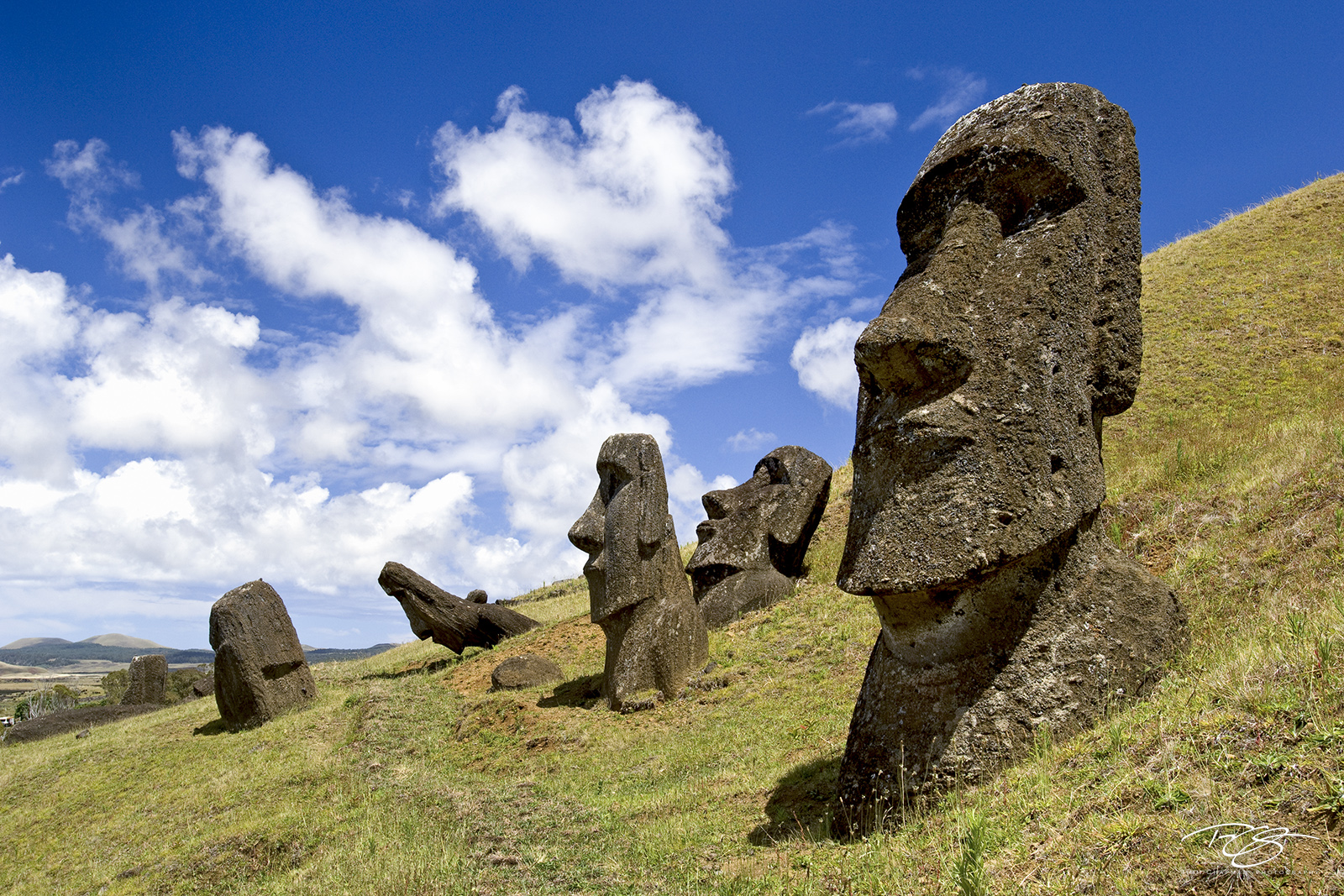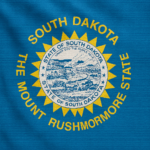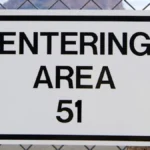
Rapa Nui (or Easter Island as it is commonly known) is most known for its giant statues; called 'Moai' (pronounced "Moe-Eye"); which in the Rapa Nui tongue; means 'image'. While there are no true 100% descendants of the original islanders left; it is uncertain what they were carved for; it is widely believed that they were to represent ancestors of the people.; They were all carved from the rock of one volcano - Rano Raraku. These Moai have patiently waited on the slopes of Rano Raraku for centuries; to move to an altar on the coast where they would watch over and protect the island's people
Easter Island, also known as Rapa Nui, is a small island located in the southeastern Pacific Ocean. It is one of the most remote inhabited islands in the world, situated about 2,182 miles (3,512 kilometers) west of mainland Chile. The island covers an area of approximately 63 square miles (163 square kilometers) and is formed by three extinct volcanoes: Terevaka, Poike, and Rano Kau. Despite its isolation, Easter Island has captured the curiosity of people worldwide due to its unique cultural heritage and the enigmatic moai statues.
The name “Easter Island” originated from the day of its European discovery. On Easter Sunday, April 5, 1722, Dutch explorer Jacob Roggeveen first set foot on the island. He named it “Easter Island” in honor of the day of his arrival. The indigenous name of the island is Rapa Nui, derived from the local Polynesian language.
The Rapa Nui people, the island’s indigenous inhabitants, have Polynesian ancestry. They have lived on Easter Island for centuries, developing their unique culture and carving the impressive moai statues. The Rapa Nui people have faced various challenges throughout history, including colonization, epidemics, and cultural changes. Today, they strive to preserve their heritage and maintain their connection to the island’s ancient traditions.
The moai statues are the most iconic feature of Easter Island. Carved by the Rapa Nui people between the 13th and 16th centuries, these massive stone sculptures were created to represent deceased ancestors. The statues range in size, with the smallest ones standing a few feet tall, while the largest can reach heights of over 30 feet (10 meters). The statues are made from a volcanic rock called tuff, which is found in the island’s quarries.
The construction and transportation of the moai statues involved remarkable engineering skills. The Rapa Nui people carved the statues directly from the cliffsides of the Rano Raraku quarry, using stone tools and a combination of techniques such as hammering, chiseling, and polishing. Once carved, the statues were transported to different locations across the island. The exact method of transportation is still a subject of debate among researchers, but it is believed that the statues were moved using a combination of sledges, ropes, and human labor. The process required careful planning, coordination, and immense physical effort.
There are a total of 887 moai statues on Easter Island, scattered across different areas of the island. The statues vary in size, with some standing a few feet tall and others towering over 30 feet (10 meters) in height. Each moai has its own unique characteristics, with variations in facial features, body proportions, and artistic style.
The largest moai statue ever erected on Easter Island is known as Paro. It stands at an impressive height of approximately 33 feet (10 meters) and weighs an estimated 75-80 tons. Paro is located in the Rano Raraku quarry, where many of the moai statues were carved.
The construction and transportation of the moai statues required meticulous planning and engineering expertise. The Rapa Nui people carved the statues directly from the volcanic rock using stone tools. They sculpted the statues in a way that allowed them to balance on a rounded base, ensuring stability when erected on the ahu platforms. The transportation of the statues involved sliding them on specially prepared paths, tilting them into an upright position using ropes and manpower, and then finally securing them on the ahu platforms.
Over time, the carving and transportation of moai statues became increasingly sophisticated. Early statues were simpler in design, with emphasis on facial features. As the tradition progressed, the statues became more elaborate, with intricate details such as carvings on the backs, clothing representations, and topknots. The moai statues reflected the evolving artistic and cultural expressions of the Rapa Nui people.
The decline of the Rapa Nui civilization is believed to have contributed to the cessation of moai carving and transportation. Factors such as overpopulation, deforestation, and depletion of natural resources led to social, environmental, and economic challenges on the island. As a result, the focus shifted away from statue production, and the island’s society underwent significant changes. Today, the remaining moai statues serve as a reminder of the Rapa Nui people’s remarkable artistic and engineering skills, as well as the challenges they faced in their history.
In 1888, Easter Island was annexed by Chile and has remained a territory of Chile ever since. The Chilean government has played a role in the preservation and management of the island’s cultural and archaeological heritage. Today, Easter Island is administered as a special territory of Chile, with its own local governance and protections in place to safeguard its unique heritage.
The indigenous script of Easter Island, known as Rongorongo, is a system of glyphs carved onto wooden tablets. It is one of the few undeciphered writing systems in the world. The exact meaning and purpose of Rongorongo remain a mystery, as no comprehensive decipherment has been achieved. Scholars continue to study and analyze the symbols in an effort to unlock the secrets of this ancient script.
Easter Island has several notable archaeological sites, apart from the quarry of Rano Raraku where the moai were carved. One of these sites is Orongo, a ceremonial village located on the southwestern coast of the island. Orongo was associated with the birdman cult, an important religious practice of the Rapa Nui people. The site features stone houses and petroglyphs related to the birdman rituals.
The first scientific expedition to Easter Island took place in 1914. Led by the Norwegian ethnographer and archaeologist Thor Heyerdahl, the expedition conducted extensive surveys and excavations on the island. Heyerdahl’s research and subsequent studies by other scholars contributed to a deeper understanding of Easter Island’s history, culture, and the significance of the moai statues.
Easter Island was designated as a UNESCO World Heritage Site in 1995. The UNESCO recognition highlights the exceptional cultural and archaeological value of the island and its moai statues. The status provides international recognition and protection, promoting the preservation and conservation of the island’s unique heritage for future generations. It also encourages sustainable tourism practices and responsible management of the site.
The annual Tapati Rapa Nui festival is a significant cultural event on Easter Island. Held in late January or early February, the festival celebrates Rapa Nui culture and traditions. It includes various activities such as traditional music, dance performances, arts and crafts exhibitions, canoe races, and sporting competitions. The festival allows both locals and visitors to immerse themselves in the rich cultural heritage of the island and experience the vibrant traditions of the Rapa Nui people.
Easter Island’s economy heavily relies on tourism. Visitors from around the world come to explore the archaeological sites, learn about the island’s history, witness the moai statues, and enjoy the natural beauty of the island. Tourism provides employment opportunities for the local community, supporting businesses such as accommodations, restaurants, tour operators, and souvenir shops. However, managing sustainable tourism practices and preserving the island’s fragile ecosystem is a key challenge faced by the authorities.
The isolation and unique ecosystem of Easter Island have contributed to the evolution of distinct flora and fauna. The island is home to several endemic species, including the Easter Island palm (Jubaea chilensis var. compacta), the Easter Island horse (Equus caballus paschalis), and several species of land birds. Protecting these endemic species and preserving the island’s biodiversity is a conservation priority.
Conservation efforts have been undertaken to safeguard the moai statues and preserve the archaeological sites of Easter Island. These include initiatives to stabilize and restore the statues, prevent further deterioration, and protect them from natural elements such as erosion and weathering. The collaboration between local authorities, archaeological teams, and international experts has been instrumental in preserving the island’s unique heritage.
Sustainable development and environmental stewardship are key considerations for Easter Island. Efforts are being made to promote responsible tourism practices, manage waste effectively, conserve water resources, and reduce the island’s carbon footprint. The goal is to strike a balance between economic development and environmental preservation, ensuring that future generations can continue to enjoy and learn from the island’s cultural and natural wonders.
Easter Island’s remote location and limited resources pose unique challenges for its inhabitants. The island relies on imported goods for daily needs such as food, fuel, and other supplies. The high cost of transportation contributes to the relatively higher prices of goods on the island compared to mainland Chile. Efforts are being made to promote sustainable agriculture and reduce dependency on imports by encouraging local food production.
The language spoken by the Rapa Nui people is called Rapa Nui, which is closely related to other Polynesian languages. In recent years, there has been a resurgence of interest in preserving and revitalizing the Rapa Nui language. Local schools and cultural organizations provide language programs to promote the continued use and transmission of Rapa Nui to younger generations.
The iconic moai statues of Easter Island have captured the imagination of people worldwide and have been a subject of artistic inspiration. They have been depicted in various art forms, including paintings, sculptures, photographs, and even in digital media. Their image has become synonymous with the island itself and has been featured in movies, documentaries, and popular culture, further amplifying the intrigue surrounding Easter Island.
Easter Island has been the subject of numerous archaeological studies, scientific research, and investigations. These studies have provided valuable insights into the island’s history, including its settlement, the construction of the moai statues, the decline of the Rapa Nui civilization, and the environmental challenges faced by its inhabitants. Ongoing research aims to uncover more about the island’s past and deepen our understanding of its unique cultural heritage.
Easter Island’s captivating landscapes, including its volcanic craters, stunning coastline, and diverse ecosystems, make it a haven for nature enthusiasts. Visitors can explore the island’s natural wonders, such as the Rano Kau volcano, the Anakena beach with its turquoise waters, and the picturesque cliffs of Orongo. The preservation of these natural areas is essential for maintaining the island’s ecological balance and ensuring the long-term sustainability of its tourism industry.









